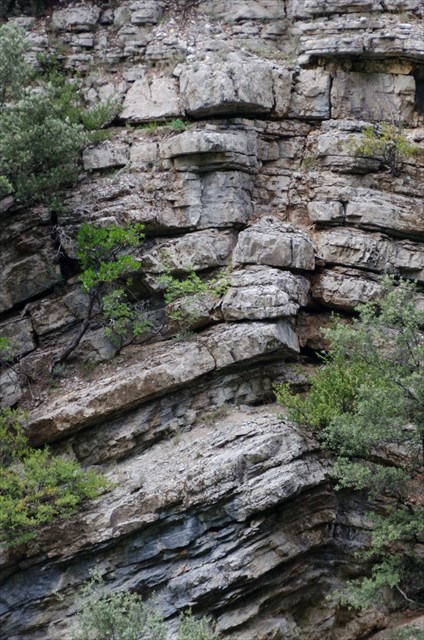

Un pli est une structure courbe due à une déformation ductile de la roche sous l'effet d'une contrainte compressive. La connaissance de la forme avant la déformation permet de la quantifier. Le cas le plus simple est le pli de roches sédimentaires, dont la structure et les marqueurs sont planaires avant la déformation.
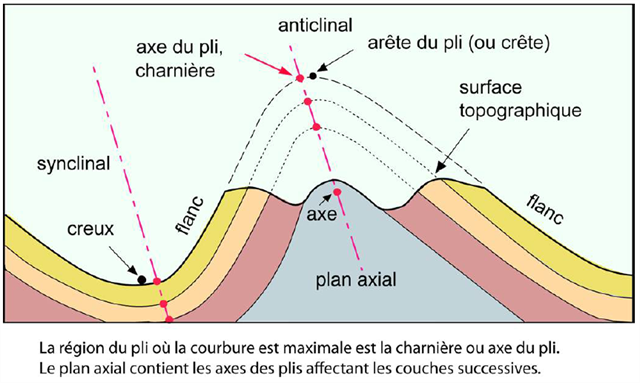
Cette figure montre les principaux éléments permettant de décrire une structure plissée. Un pli résulte de la formation continue (c’est-à-dire sans rupture ou ductile) d’une couche initialement plane : couche d’origine sédimentaire ou litage magmatique et métamorphique (coulée, sill, pluton, foliation, migmatites, etc.) Le plissement induit la modification du pendage initial des couches. Il en résulte des géométries dans lesquelles les couches ont un pendage opposé. La partie convexe vers le ciel est une antiforme, la partie concave est une synforme. Si le plissement affecte une série sédimentaire à l’endroit (polarité normale) alors l’antiforme est un anticlinal et la synforme un synclinal.
Les flancs du pli correspondent à des parties ayant un pendage de même sens : ce sont des structures monoclinales.
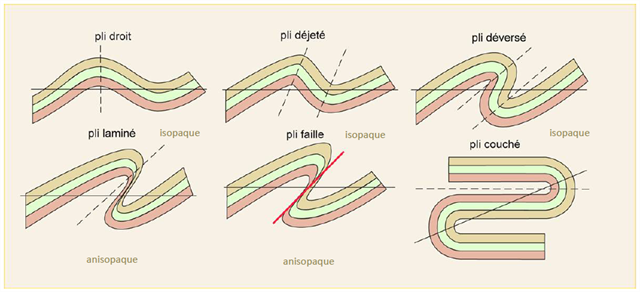
L’attitude du plan axial dans l’espace permet de décrire la géométrie d’ensemble du pli. Si l’épaisseur des couches est conservée durant la déformation, le pli est dit isopaque (même épaisseur.)
Pour caractériser totalement la forme d’un pli on ajoute à ce critère d’inclinaison, la notion d’étirement (ou laminage) des flancs pouvant conduire à la rupture de la continuité des couches entre deux axes de plis. Un pli dont les flancs sont étirés est dit anisopaque.
Ainsi, le pli laminé est un pli déversé anisopaque. Le pli faille est un pli laminé dont l’étirement extrême des couches dans le plan axial a conduit à la rupture. Il en résulte l’apparition d’une faille inverse, d’où le terme de pli faille.
Pour valider la cache
-- Conformément aux guidelines de Groundspeak --
Envoyez-moi vos propositions de réponses soit via mon profil, soit via la messagerie geocaching (Message Center), PUIS loguez cette cache 'Found it'. Je vous contacterai en cas de problème.
Vu le nombre de logs que je reçois sans message, tout log posté sans avoir envoyé les réponses aux questions sera supprimé sans avertissement.
1. De quel type de pli avons-nous affaire ici ?
2. Combien d’anticlinal peut-on observer ?
3. [Optionnel] Une photo de vous et/ou de votre GPS sur le site (à inclure dans le log.)
|

A fold is a curve structure due to a deformation of the ductile rock under the effect of a compressive stress. The knowledge of the shape before the deformation allows to quantify it. The simplest case is the fold of sedimentary rocks for whom the structure and the markers are planar prior to the deformation.
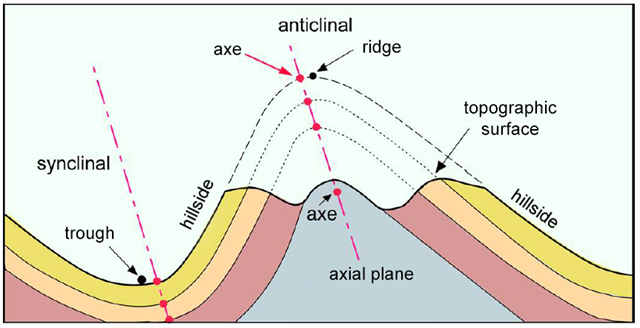
This figure shows the main elements used to describe a pleated structure. A fold result of the continuous formation (without breaking or ductile) of an initially flat layer: magmatic and metamorphic or sedimentary layer (sill, pluton, foliation, migmatites layer...). The folding induced modification of the initial dip of the layers. As a result of the geometries in which the layers have an opposite dip. The convex part in the direction of the sky is an antiform, the concave part is a synform. If the wrinkling affects a sedimentary series in the place (normal polarity) then the antiform is an anticline and the synform a syncline.
The flanks of the fold correspond to parts having a dip in the same direction: they are monoclinal structures.
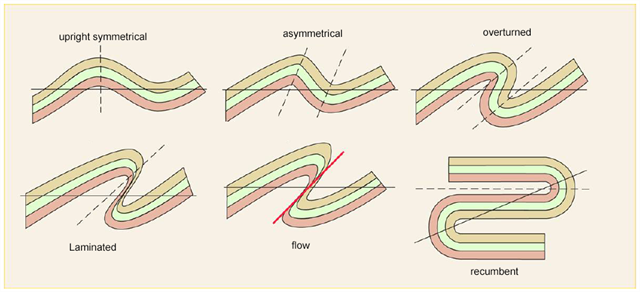
The attitude of the axial plane in space is used to describe the geometry of the fold. If the thickness of the layers is preserved during the deformation, the fold is said isopach (same thickness.)
To fully characterize the form of a fold, we add to this tilt criterion, the concept of stretching (or rolling) of the sidewalls that can lead to rupture of the continuity of the layers between two fold axes. A fold whose sides are stretched is said anisopach.
Thus, the laminated fold is a spilled anisopach fold. The flow fold is a laminated fold whose extreme stretching of the layers in the axial plane led to the rupture. This results in the occurrence of a reverse flow, hence the term of flow fold.
To validate the cache
-- In accordance with Groundspeak guidelines --
Send me your suggested answers via my profile either via messaging geocaching (Message Center), THEN log this cache 'Found it'. I will contact you in case of problems.
Given the number of logs I receive without a message, any log posted without having sent the answers to the questions will be deleted without warning.
1. What kind of fold is here?
2. How many anticlinal can we see?
3. [Optional] A picture of you and/or your GPS (to be included to the log)
|